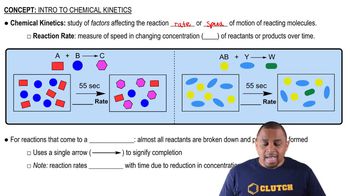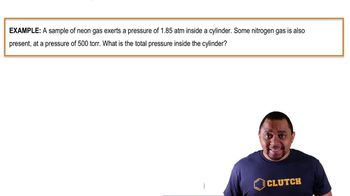The tabulated data were collected for this reaction at a certain temperature: X2Y → 2 X + Y c. What is the concentration of X after 10.0 hours?
At 700 K, acetaldehyde decomposes in the gas phase to methane and carbon monoxide. The reaction is: CH3CHO(g) → CH4(g) + CO(g). A sample of CH3CHO is heated to 700 K and the pressure is measured as 0.22 atm before any reaction takes place. The kinetics of the reaction are followed by measurements of total pressure and these data are obtained: t (s) 0 1000 3000 7000; PTotal (atm) 0.22 0.24 0.27 0.31. Find the rate law, the rate constant, and the total pressure after 2.00 × 10^4 s.
 Verified step by step guidance
Verified step by step guidanceKey Concepts
Chemical Kinetics

Rate Law

Equilibrium and Total Pressure

Consider the reaction: 2 O3(g) → 3 O2( g) The rate law for this reaction is: Rate = k [O3]2 [O2] Suppose that a 1.0-L reaction vessel initially contains 1.0 mol of O3 and 1.0 mol of O2. What fraction of the O3 will have reacted when the rate falls to one-half of its initial value?
Dinitrogen pentoxide decomposes in the gas phase to form nitrogen dioxide and oxygen gas. The reaction is first order in dinitrogen pentoxide and has a half-life of 2.81 h at 25 °C. If a 1.5-L reaction vessel initially contains 745 torr of N2O5 at 25 °C, what partial pressure of O2 is present in the vessel after 215 minutes?
Iodine atoms combine to form I2 in liquid hexane solvent with a rate constant of 1.5⨉1010 L/mols. The reaction is second order in I. Since the reaction occurs so quickly, the only way to study the reaction is to create iodine atoms almost instantaneously, usually by photochemical decomposition of I2. Suppose a flash of light creates an initial [I] concentration of 0.0100 M. How long will it take for 95% of the newly created iodine atoms to recombine to form I2?
